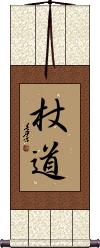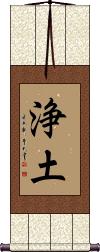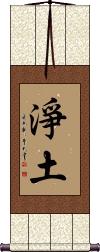Many custom options...
And formats...

Jodo in Chinese / Japanese...
Buy a Jodo calligraphy wall scroll here!
Personalize your custom “Jodo” project by clicking the button next to your favorite “Jodo” title below...
Jodo
Pure Land / Jodo
浄土 means “Pure Land.”
This term, “Pure Land” is often associated with the Western Pure Land paradise of Amitabha, also known as the “Buddhist paradise.”
浄土 can also be used as an abbreviation for “Pure Land Buddhism.”
You may see this romanized as Jodo, Joudo, or Jōdo. Some also combine Pure Land into Pureland in English.
This can also be a Japanese surname with the same Jodo or Joudo pronunciation.
See Also: Shin Buddhism
Pure Land / Jodo
Also a sect of Buddhism
淨土 literally means “pure land” or “clean earth.”
淨土 is also the abbreviated title of a Buddhist sect that involves faith in the rebirth of Buddha Amitabha (Amitābha) in the Western Heaven. Sometimes this sect is translated as “Paradise of the West.” Other titles of this school of Buddhism include Amidism or Elysium.
See Also: Nirvana | Shin Buddhism
Pure Land Buddhism / Jodo Buddhism
浄土宗 is the title of Japanese “Pure Land Buddhism.” This form is also romanized/known as “Jodo Shu” (jōdo shū).
Also known as Amidism for the fact that this is a branch of Mahayana (Mahāyāna) Buddhism which focuses on Amitabha (Amitābha) Buddha. This form of Buddhism, along with Chinese characters, came to Japan via China in the 5th century, according to most historians.
Notes:
Pure Land Buddhism is also known as ![]()
![]()
![]()
![]() (jōdo bukkyō).
(jōdo bukkyō).
Some will just express it with just ![]()
![]() (Pure Land).
(Pure Land).
See Also: Shin Buddhism
Shinto Muso-Ryu
Not the results for jodo that you were looking for?
Below are some entries from our dictionary that may match your jodo search...
| Characters If shown, 2nd row is Simp. Chinese |
Pronunciation Romanization |
Simple Dictionary Definition |
杖道 see styles |
joudou / jodo じょうどう |
More info & calligraphy: Jodo |
浄土 see styles |
joudo / jodo じょうど |
More info & calligraphy: Pure Land / Jodo |
淨土 净土 see styles |
jìng tǔ jing4 tu3 ching t`u ching tu jōdo |
More info & calligraphy: Pure Land / JodoSukhāvatī. The Pure Land, or Paradise of the West, presided over by Amitābha. Other Buddhas have their Pure Lands; seventeen other kinds of pure land are also described, all of them of moral or spiritual conditions of development, e.g. the pure land of patience, zeal, wisdom, etc. |
浄土宗 see styles |
joudoshuu / jodoshu じょうどしゅう |
More info & calligraphy: Pure Land Buddhism / Jodo Buddhism |
淨土宗 净土宗 see styles |
jìng tǔ zōng jing4 tu3 zong1 ching t`u tsung ching tu tsung Jōdo Shū |
More info & calligraphy: Pure Land Buddhism / Jodo BuddhismThe Pure-land sect, whose chief tenet is salvation by faith in Amitābha; it is the popular cult in China, also in Japan, where it is the Jōdo sect; it is also called 蓮宗(蓮花宗) the Lotus sect. Established by Hui-yuan 慧遠 of the Chin dynasty (317— 419), it claims P'u-hsien 普賢 Samantabhadra as founder. Its seven chief textbooks are 無量淸淨平等覺經; 大阿彌陀經; 無量壽經; 觀無量壽經; 阿彌陀經; 稱讚淨土佛攝受經; and 鼓音聲三陀羅尼經. The淨土眞宗 is the Jōdo-Shin, or Shin sect of Japan. |
浄土真宗 see styles |
joudoshinshuu / jodoshinshu じょうどしんしゅう |
More info & calligraphy: Shin Buddhism |
宗 see styles |
zōng zong1 tsung motoi もとい |
school; sect; purpose; model; ancestor; clan; to take as one's model (in academic or artistic work); classifier for batches, items, cases (medical or legal), reservoirs (1) (rare) origin; source; (2) (rare) virtuous ancestor; (given name) Motoi Ancestors, ancestral; clan; class, category. kind; school, sect; siddhānta, summary, main doctrine, syllogism, proposition, conclusion, realization. Sects are of two kinds: (1) those founded on principles having historic continuity, as the twenty sects of the Hīnayāna, the thirteen sects of China, and the fourteen sects of Japan: (2) those arising from an individual interpretation of the general teaching of Buddhism, as the sub-sects founded by Yongming 永明 (d. 975), 法相宗, 法性宗, 破相宗, or those based on a peculiar interpretation of one of the recognized sects, as the Jōdo-shinshū 淨土眞宗 found by Shinran-shōnin. There are also divisions of five, six, and ten, which have reference to specific doctrinal differences. Cf. 宗派. |
一向 see styles |
yī xiàng yi1 xiang4 i hsiang hitomukai ひとむかい |
a period of time in the recent past; (indicating a period of time up to the present) all along; the whole time (adverb) (1) (See 一向に・1) completely; absolutely; totally; (adverb) (2) (in a negative sentence) (not) at all; (not) a bit; (not) in the least; (adverb) (3) earnestly; intently; determinedly; (4) (abbreviation) (See 一向宗) Jōdo Shinshū; (surname) Hitomukai One direction, each direction; with single mind, the mind fixed in one direction undistracted; e.g. 一向淸淨無有女人 (The land of that Buddha is) everywhere pure; no women are there. |
一念 see styles |
yī niàn yi1 nian4 i nien kazune かずね |
(1) determined purpose; (2) {Buddh} an incredibly short span of time (i.e. the time occupied by a single thought); (3) {Buddh} (See 浄土宗) a single repetition of a prayer (esp. in Jodo-shu); (personal name) Kazune A kṣaṇa, or thought; a concentration of mind; a moment; the time of a thought, of which there are varying measurements from 60 kṣaṇa upwards; the Fan-yi-ming-yi makes it one kṣaṇa. A reading. A repetition (especially of Amitābha's name). The Pure-land sect identify the thought of Buddha with Amitābha's vow, hence it is an assurance of salvation. |
乘道 see styles |
shèng dào sheng4 dao4 sheng tao jōdō |
vehicle path |
九宗 see styles |
jiǔ zōng jiu3 zong1 chiu tsung ku shū |
The eight sects 八宗 (q.v.) plus the 禪宗 Chan or Zen, or the Pure-land or Jōdo sect. |
助動 see styles |
jodou / jodo じょどう |
(abbreviation) (part of speech tag used in dictionaries) (See 助動詞・1) inflecting dependent word |
助業 助业 see styles |
zhù yè zhu4 ye4 chu yeh jogou / jogo じょごう |
{Buddh} (See 浄土宗) auxiliary actions (in Jodo: recitation, observation, worship, praise and offering) Auxiliary karma, i.e. deeds or works, e.g. reciting the sutras about the Pure Land, worship, praise, and offering, as additional to direct karma 正業, i.e. faith in Amitābha, expressed by constant thought of him and calling on his name. |
十宗 see styles |
shí zōng shi2 zong1 shih tsung jūshū |
The ten schools of Chinese Buddhism: I. The (1) 律宗 Vinaya-discipline, or 南山|; (2) 倶舍 Kośa, Abhidharma, or Reality (Sarvāstivādin) 有宗; (3) 成實宗 Satyasiddhi sect founded on this śāstra by Harivarman; (4) 三論宗 Mādhyamika or 性空宗; (5) 法華宗 Lotus, "Law-flower" or Tiantai 天台宗; (6) 華嚴Huayan or法性 or賢首宗; ( 7) 法相宗 Dharmalakṣana or 慈恩宗 founded on the唯識論 (8) 心宗 Ch'an or Zen, mind-only or intuitive, v. 禪宗 ; (9) 眞言宗 (Jap. Shingon) or esoteric 密宗 ; (10) 蓮宗 Amitābha-lotus or Pure Land (Jap. Jōdo) 淨士宗. The 2nd, 3rd, 4th, and 9th are found in Japan rather than in China, where they have ceased to be of importance. II. The Hua-yen has also ten divisions into ten schools of thought: (1) 我法倶有 the reality of self (or soul) and things, e.g. mind and matter; (2) 法有我無 the reality of things but not of soul; (3) 法無去來 things have neither creation nor destruction; (4) 現通假實 present things are both apparent and real; (5) 俗妄眞實 common or phenomenal ideas are wrong, fundamental reality is the only truth; (6) things are merely names; (7) all things are unreal 空; (8) the bhūtatathatā is not unreal; (9) phenomena and their perception are to be got rid of; (10) the perfect, all-inclusive, and complete teaching of the One Vehicle. III. There are two old Japanese divisions: 大乘律宗, 倶舎宗 , 成實 宗 , 法和宗 , 三論宗 , 天台宗 , 華嚴宗 , 眞言宗 , 小乘律宗 , and 淨土宗 ; the second list adds 禪宗 and omits 大乘律宗. They are the Ritsu, Kusha, Jōjitsu, Hossō, Sanron, Tendai, Kegon, Shingon, (Hīnayāna) Ritsu, and Jōdo; the addition being Zen. |
城土 see styles |
joudo / jodo じょうど |
(surname) Jōdo |
城戸 see styles |
joudo / jodo じょうど |
(place-name, surname) Jōdo |
壌土 see styles |
joudo / jodo じょうど |
(1) soil; (2) loamy soil; loam; soil with clay content of 25-37.5% |
如童 see styles |
jodou / jodo じょどう |
(given name) Jodou |
宗派 see styles |
zōng pài zong1 pai4 tsung p`ai tsung pai shuuha / shuha しゅうは |
sect (1) sect; denomination; (2) school (e.g. of poetry) Sects (of Buddhism). In India, according to Chinese accounts, the two schools of Hīnayāna became divided into twentysects. Mahāyāna had two main schools, the Mādhyamika, ascribed to Nāgārjunaand Āryadeva about the second century A. D., and the Yogācārya, ascribed toAsaṅga and Vasubandhu in the fourth century A. D. In China thirteen sectswere founded: (1) 倶舍宗 Abhidharma or Kośa sect, representing Hīnayāna,based upon the Abhidharma-kosa-śāstra or 倶舍論. (2) 成實宗 Satyasiddhi sect, based on the 成實論 Satyasiddhi-śāstra,tr. by Kumārajīva; no sect corresponds to it in India; in China and Japan itbecame incorporated in the 三論宗. (3) 律宗 Vinaya or Discipline sect, basedon 十誦律, 四分律, 僧祗律, etc. (4) 三論宗 The three śāstra sect, based on theMādhyamika-śāstra 中觀論 of Nāgārjuna, theSata-śāstra 百論 of Āryadeva, and theDvādasa-nikāya-śāstra 十二門論 of Nāgārjuna; this schooldates back to the translation of the three śāstras by Kumārajīva in A. D. 409. (5) 涅槃宗 Nirvāṇasect, based upon the Mahāparinirvāṇa-sūtra 涅槃經 tr. byDharmaraksa in 423; later incorporated in Tiantai, with which it had much incommon. (6) 地論宗 Daśabhūmikā sect, based on Vasubandhu's work on the tenstages of the bodhisattva's path to Buddhahood, tr. by Bodhiruci 508,absorbed by the Avataṃsaka school, infra. (7) 淨土宗 Pure-land or Sukhāvatīsect, founded in China by Bodhiruci; its doctrine was salvation throughfaith in Amitābha into the Western Paradise. (8) 禪宗 dhyāna, meditative or intuitional sect, attributed toBodhidharma about A. D. 527, but it existed before he came to China. (9) 攝論宗, based upon the 攝大乘論 Mahāyāna-saṃparigraha-śāstra byAsaṅga, tr. by Paramārtha in 563, subsequently absorbed by the Avataṃsakasect. (10) 天台宗 Tiantai, based on the 法華經 SaddharmapuṇḍarīkaSūtra, or the Lotus of the Good Law; it is aconsummation of the Mādhyamika tradition. (11) 華嚴宗 Avataṃsaka sect, basedon the Buddhāvataṃsaka-sūtra, or Gandha-vyūha 華嚴經 tr. in 418. (12) 法相宗 Dharmalakṣaṇa sect, established after thereturn of Xuanzang from India and his trans. of the important Yogācāryaworks. (13) 眞言宗 Mantra sect, A. D. 716. In Japan twelve sects are named:Sanron, Hossō, Kegon, Kusha, Jōjitsu, Ritsu, Tendai, Shingon; these areknown as the ancient sects, the two last being styled mediaeval; therefollow the Zen and Jōdo; the remaining two are Shin and Nichiren; at presentthere are the Hossō, Kegon, Tendai, Shingon, Zen, Jōdo, Shin, and Nichirensects. |
常渡 see styles |
joudo / jodo じょうど |
(place-name) Jōdo |
恕堂 see styles |
jodou / jodo じょどう |
(given name) Jodou |
情動 see styles |
joudou / jodo じょうどう |
emotion; affect |
正行 see styles |
zhèng xíng zheng4 xing2 cheng hsing masayuki まさゆき |
{Buddh} (See 助業,浄土宗,正定業) correct practices (esp. in Jodo, the path to rebirth in paradise); (p,s,g) Masayuki Right deeds, or action, opposite of 邪行. |
淨道 净道 see styles |
jìng dào jing4 dao4 ching tao jōdō |
The pure enlightenment of Buddha. |
親鸞 亲鸾 see styles |
qīn luán qin1 luan2 ch`in luan chin luan shinran しんらん |
(person) Shinran (founder of the Jōdo Shinshū sect of Buddhism, 1173-1262) Shinran |
諸行 诸行 see styles |
zhū xíng zhu1 xing2 chu hsing shogyou / shogyo しょぎょう |
(1) {Buddh} all worldly phenomena; meritorious acts leading to enlightenment; (2) (Jodo school) all practices other than recitation of the nembutsu prayer All phenomenal changes; all conduct or action. |
門徒 门徒 see styles |
mén tú men2 tu2 men t`u men tu monto もんと |
disciple follower (of religion; esp. Jōdo Shinshū practitioners); believer disciple |
一向宗 see styles |
yī xiàng zōng yi1 xiang4 zong1 i hsiang tsung ikkoushuu / ikkoshu いっこうしゅう |
(See 浄土真宗) Ikkō sect (of Buddhism); Jōdo Shinshū; True Pure Land School The 眞宗 Shin or Pure-land Shin Sect founded by Shinran, in Japan, whose chief tenet is unwavering reflection on Amida (by repeating his name). |
上堂牌 see styles |
shàng táng pái shang4 tang2 pai2 shang t`ang p`ai shang tang pai jōdō hai |
The tablet announcing the time of worship at a temple or monastery. |
不來迎 不来迎 see styles |
bù lái yíng bu4 lai2 ying2 pu lai ying fu raigō |
Without being called he comes to welcome; the Pure-land sect believes that Amitābha himself comes to welcome departing souls of his followers on their calling upon him, but the 淨土眞宗 (Jōdo Shin-shu sect) teaches that belief in him at any time ensures rebirth in the Pure Land, independently of calling on him at death. |
Click here for more jodo results from our dictionary
The following table may be helpful for those studying Chinese or Japanese...
| Title | Characters | Romaji (Romanized Japanese) | Various forms of Romanized Chinese | |
| Jodo | 杖道 | joudou / jodo jodo / jodo | ||
| Pure Land Jodo | 浄土 | jou do / joudo / jo do | jìng tǔ / jing4 tu3 / jing tu / jingtu | ching t`u / chingtu / ching tu |
| Pure Land Jodo | 淨土 净土 | jou do / joudo / jo do | jìng tǔ / jing4 tu3 / jing tu / jingtu | ching t`u / chingtu / ching tu |
| Pure Land Buddhism Jodo Buddhism | 淨土宗 浄土宗 | jou do shuu joudoshuu jo do shu | jìng tǔ zōng jing4 tu3 zong1 jing tu zong jingtuzong | ching t`u tsung chingtutsung ching tu tsung |
| Shinto Muso-Ryu | 神道夢想流 | shin tou mu sou ryuu shintoumusouryuu shin to mu so ryu | ||
| In some entries above you will see that characters have different versions above and below a line. In these cases, the characters above the line are Traditional Chinese, while the ones below are Simplified Chinese. | ||||
Successful Chinese Character and Japanese Kanji calligraphy searches within the last few hours...








